- Calendar
- Online Ticket Sales
- Access
- JA
- EN
Brief History
1899
- Feb.1
- Shinjiro Torii (Suntory’s founder) launches the Torii Shoten store in Osaka.
1921
- Kotobukiya Limited is founded.
The social welfare organization Hojukai is also founded.
1961
- Jun. - Sep.
- Writing box with scenery of Mt. Ogura in maki-e (Important Cultural Property), Low desk with chrysanthemum design in maki-e, and Namban, folding screens attributed to Kanō Sanraku, are acquired.
- Nov.20
- Suntory Museum of Art opens on the 9th floor of the Palace Building, 1-10, Marunouchi, Chiyoda-ku, Tokyo. Its first president is Keizo Saji, second president of Suntory.
- Nov.21
- The first exhibition, Inaugural Commemoration Exhibition: Art in Life, is held.
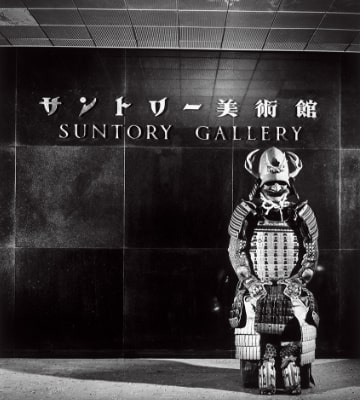
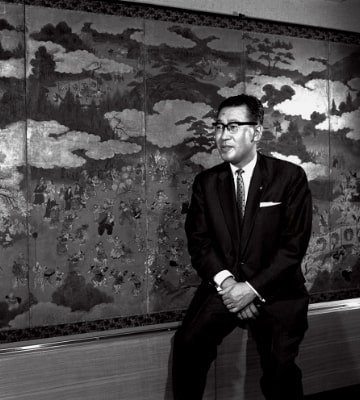
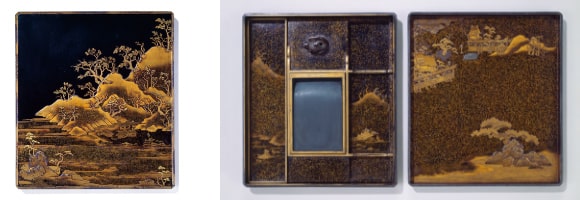
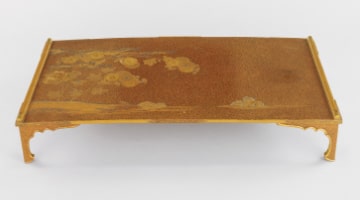
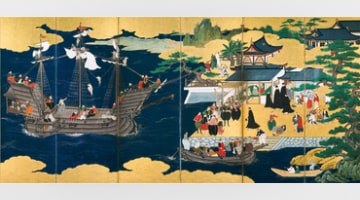
1962
- Jun.21
- Low desk with chrysanthemum design in maki-e is designated an Important Cultural Property.
- June
- Accessary box with fusenryō design in mother-of-pearl inlay and maki-e (Important Cultural Property) is acquired.
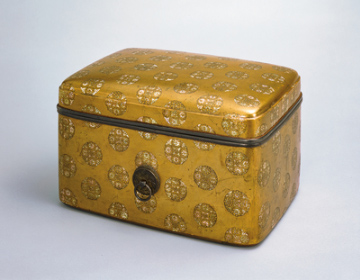
1964
- May 26
- Accessary box with fusenryō design in mother-of-pearl inlay and maki-e is designated a National Treasure.
1967
- September
- The Tale of Zenkyōbō picture scroll (Important Cultural Property) is acquired.
- Nov.7
- Art in Life: Works from the Suntory Museum of Art, the museum’s first external exhibition, is held at the Imai department store, Sapporo, Hokkaido.
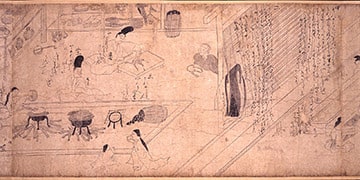
1968
- Jun.7
- Arte Tradicional del Japón (Japanese Traditional Art), the first overseas exhibition of the museum’s collection, is held at the Palace of Fine Arts, Mexico City, Mexico. The exhibition period is extended by two weeks due to its popularity; it attracted a total of 71,154 visitors.
- December
- Low desk and writing box with design of paulownia, bamboo, and phoenix in maki-e (Important Cultural Property) are acquired.
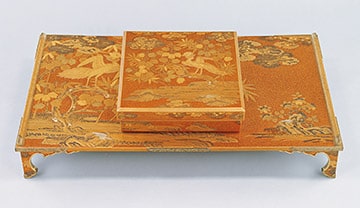
1971
- Mar.20
- Japanese Traditional Arts: Art in Life is held at the Government of the Ryukyu Islands Museum, Okinawa (now the Okinawa Prefectural Museum and Art Museum). (Regarded as an overseas exhibition, since Okinawa had not yet reverted to Japan.)
1974
- Jul.22
- Overseas exhibition, ИСКУССТВО ЯПОНСКОГО БЫТА XV-XIX ВЕКОВ (Art in Life in Japan from 15th to 19th centuries), is held at the Pushkin State Museum of Fine Arts, Moscow in the USSR.
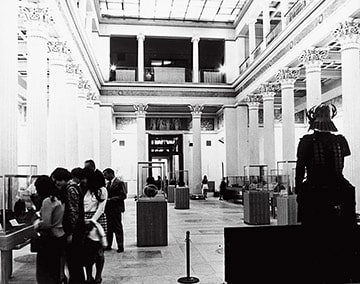
1975
- May 22
- Museum moves and reopens on the 11th floor of the Suntory Building, 1-2-3, Motoakasaka, Minato-ku, Tokyo. Inaugural (Akasaka) Commemoration Exhibition: Japanese Arts, Tradition and Creation, is held.
- Oct.14
- Handcrafts and Icons of Russia, from 16th to Early 20th Centuries, an exhibition of work from the collections of the Zagorsk and Kolomenskoye museums in the USSR; first major exhibition of a collection from overseas.
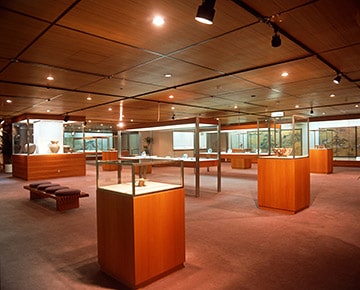
1977
- December
- The glass collection of the sculptor Fumio Asakura (Satsuma kiriko, Qianlong glass, and many other examples of Japanese and Chinese glass) is acquired.
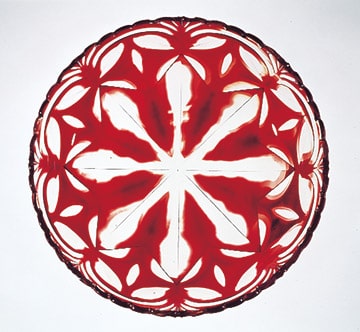
1978
- May 25
- Overseas exhibition, Genre Screens from the Suntory Museum of Art, is held at Japan House Gallery, New York in the USA.
1979
- June
- Western Kings on Horseback folding screens (Important Cultural Property) are acquired.
- Aug.7
- Otogi-zōshi and Nara-ehon, Special Exhibition of Works in Collections Overseas is held in conjunction with a meeting of the International Study Group on Nara-ehon.
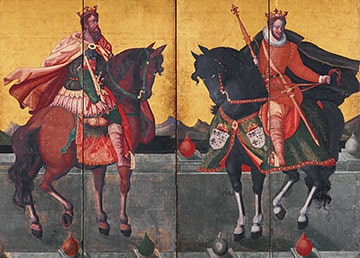
1983
- Sep.15
- Overseas exhibition, Autumn Grasses and Water Motifs in Japanese Art, is held at Japan House Gallery, New York in the USA.
- Oct.21
- Suntory Music Culture exhibition: The Real Beethoven is held in conjunction with the construction of Suntory Hall. Nine Suntory Music Culture exhibitions are held, until 1992.
1984
- Jun.6
- Flowers and Birds of Four Seasons folding screens, attributed to Tosa Hirochika, are designated an Important Cultural Property
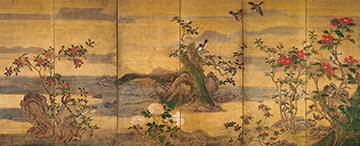
1986
- Dec.9
- Commemorating a Quarter Century: Kōgei— Leaders at the End of the Century exhibition is held; first exhibition of contemporary art.
1987
- Feb.10
- TALES OF JAPAN: Scrolls from the New York Public Library exhibition is held, displaying the library’s collection of Japanese art.
1988
- Sep.6
- Tales of Japan: Ireland Chester Beatty Collection exhibition is held.
- Oct.25
- The Suntory Prize Exhibition ’88 is held; held eight times, until 1998, as The Suntory Prize Exhibition.
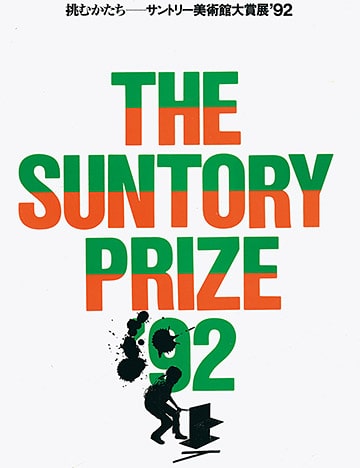
1989
- Oct.21
- The Fujinoki Kofun and Its Age exhibition is held. Number of visitors reaches 75,503.
1991
- Oct.3
- Imitation & Inspiration—Japanese Influence on Dutch Art exhibition is held, in commemoration of the visit to Japan of Her Majesty Queen Beatrix.
1994
- May
- The Yasunari Kikuchi collection of glass works by Emile Gallé and others is acquired.
- October
- Portrait of Minamoto no Shitagō from the Satake version of the Thirty-six Immortal Poets (Important Cultural Property) is acquired.
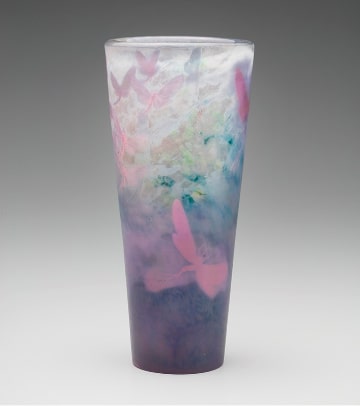
(Kikuchi Collection)
©Keizo Kioku
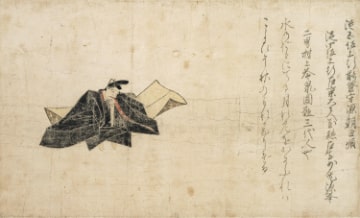
1996
- Jun.27
- Namban folding screens, attributed to Kanō Sanraku, Covered box with silver grass design in white slip, underglaze blue, and gold by Ogata Kenzan, and Large octangular covered jar with bird-and-flower design in overglaze enamels are designated Important Cultural Properties.
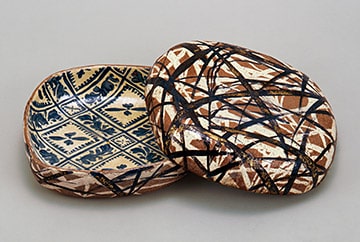
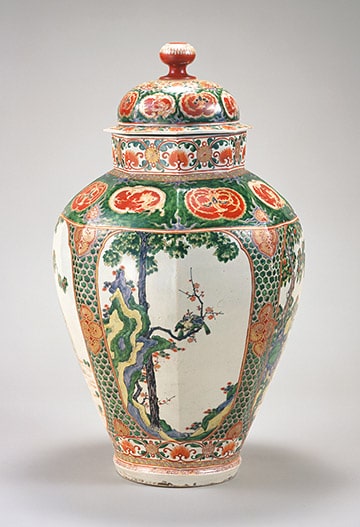
1997
- Jun.30
- Top-shaped bowl with five ships design in overglaze enamels is designated an Important Cultural Property.
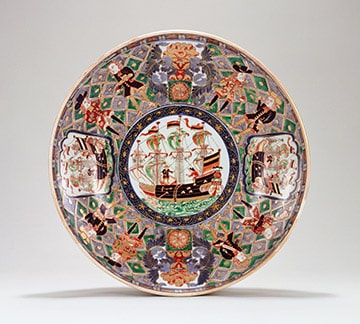
2000
- Dec.4
- Three-footed dish with pine tree in underglaze blue is designated an Important Cultural Property.
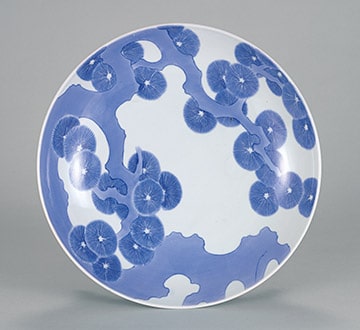
2004
- Dec.30
- The exhibition, Salute to Akasaka-Mitsuke: Suntory Museum of Art Fine Art Exhibition— Art in Life 1975-2004, is held, and the museum is temporarily closed.
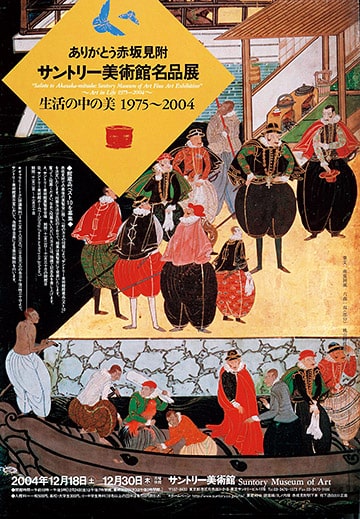
2007
- Mar.30
- Museum moves and reopens in Tokyo Midtown Galleria 3rd floor, 9-7-4 Akasaka, Minato-ku, Tokyo. An Exhibition Commemorating the New Home of the Suntory Museum of Art Iwai:Arts of Celebration is held.
2009
- Sep.1
- The Suntory Foundation for the Arts is founded.
2011
- Mar.19
- Celebrates the 50th anniversary of the museum’s opening with the Art Revisited, Beauty Revealed exhibition.
2012
- December
- Woman with Insomnia, from the Scroll of Diseases and Deformities, fragment (Important Cultural Property) is acquired.
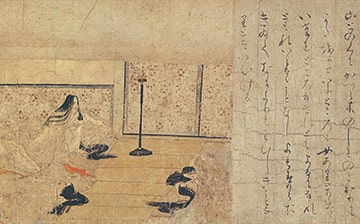
2015
- June
- Conquest of Shutendōji, by Kanō Motonobu, is designated an Important Cultural Property.
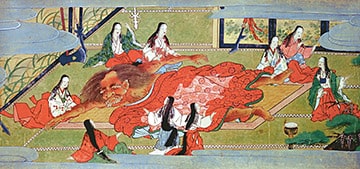
2016
- April
- Western-style sugoroku game board with Kiyomizu-dera Temple and Sumiyoshi-taisha Shrine design in Maki-e (Important Cultural Property) is acquired.
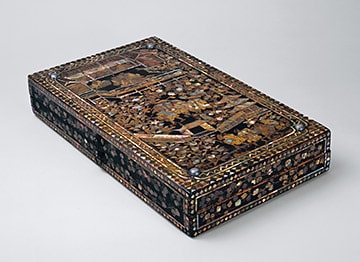
2017
- March
- Exhibitions and events commemorating a decade in Roppongi are held throughout the year.
2019
- Nov.11
- Museum closes temporarily for renovation.
2020
- Jul.22
- Museum reopens with commemorative exhibitions.
2023 January
- Exhibition
- Closed
- Tea Ceremony
- Mon
- Tue
- Wed
- Thu
- Fri
- Sat
- Sun
- 1
- 2
- 3
- 4
- 5
- 6
- 7
- 8
- 9
- 10
- 11
- 12
- 13
- 14
- 15
- 16
- 17
- 18
- 19
- 20
- 21
- 22
- 23
- 24
- 25
- 26
- 27
- 28
- 29
- 30
- 31
2023 February
- Exhibition
- Closed
- Tea Ceremony
- Mon
- Tue
- Wed
- Thu
- Fri
- Sat
- Sun
- 1
- 2
- 3
- 4
- 5
- 6
- 7
- 8
- 9
- 10
- 11
- 12
- 13
- 14
- 15
- 16
- 17
- 18
- 19
- 20
- 21
- 22
- 23
- 24
- 25
- 26
- 27
- 28
2023 March
- Exhibition
- Closed
- Tea Ceremony
- Mon
- Tue
- Wed
- Thu
- Fri
- Sat
- Sun
- 1
- 2
- 3
- 4
- 5
- 6
- 7
- 8
- 9
- 10
- 11
- 12
- 13
- 14
- 15
- 16
- 17
- 18
- 19
- 20
- 21
- 22
- 23
- 24
- 25
- 26
- 27
- 28
- 29
- 30
- 31
2023 April
- Exhibition
- Closed
- Tea Ceremony
- Mon
- Tue
- Wed
- Thu
- Fri
- Sat
- Sun
- 1
- 2
- 3
- 4
- 5
- 6
- 7
- 8
- 9
- 10
- 11
- 12
- 13
- 14
- 15
- 16
- 17
- 18
- 19
- 20
- 21
- 22
- 23
- 24
- 25
- 26
- 27
- 28
- 29
- 30
2023 May
- Exhibition
- Closed
- Tea Ceremony
- Mon
- Tue
- Wed
- Thu
- Fri
- Sat
- Sun
- 1
- 2
- 3
- 4
- 5
- 6
- 7
- 8
- 9
- 10
- 11
- 12
- 13
- 14
- 15
- 16
- 17
- 18
- 19
- 20
- 21
- 22
- 23
- 24
- 25
- 26
- 27
- 28
- 29
- 30
- 31
2023 June
- Exhibition
- Closed
- Tea Ceremony
- Mon
- Tue
- Wed
- Thu
- Fri
- Sat
- Sun
- 1
- 2
- 3
- 4
- 5
- 6
- 7
- 8
- 9
- 10
- 11
- 12
- 13
- 14
- 15
- 16
- 17
- 18
- 19
- 20
- 21
- 22
- 23
- 24
- 25
- 26
- 27
- 28
- 29
- 30
2023 July
- Exhibition
- Closed
- Tea Ceremony
- Mon
- Tue
- Wed
- Thu
- Fri
- Sat
- Sun
- 1
- 2
- 3
- 4
- 5
- 6
- 7
- 8
- 9
- 10
- 11
- 12
- 13
- 14
- 15
- 16
- 17
- 18
- 19
- 20
- 21
- 22
- 23
- 24
- 25
- 26
- 27
- 28
- 29
- 30
- 31
2023 August
- Exhibition
- Closed
- Tea Ceremony
- Mon
- Tue
- Wed
- Thu
- Fri
- Sat
- Sun
- 1
- 2
- 3
- 4
- 5
- 6
- 7
- 8
- 9
- 10
- 11
- 12
- 13
- 14
- 15
- 16
- 17
- 18
- 19
- 20
- 21
- 22
- 23
- 24
- 25
- 26
- 27
- 28
- 29
- 30
- 31
2023 September
- Exhibition
- Closed
- Tea Ceremony
- Mon
- Tue
- Wed
- Thu
- Fri
- Sat
- Sun
- 1
- 2
- 3
- 4
- 5
- 6
- 7
- 8
- 9
- 10
- 11
- 12
- 13
- 14
- 15
- 16
- 17
- 18
- 19
- 20
- 21
- 22
- 23
- 24
- 25
- 26
- 27
- 28
- 29
- 30
2023 October
- Exhibition
- Closed
- Tea Ceremony
- Mon
- Tue
- Wed
- Thu
- Fri
- Sat
- Sun
- 1
- 2
- 3
- 4
- 5
- 6
- 7
- 8
- 9
- 10
- 11
- 12
- 13
- 14
- 15
- 16
- 17
- 18
- 19
- 20
- 21
- 22
- 23
- 24
- 25
- 26
- 27
- 28
- 29
- 30
- 31
2023 November
- Exhibition
- Closed
- Tea Ceremony
- Mon
- Tue
- Wed
- Thu
- Fri
- Sat
- Sun
- 1
- 2
- 3
- 4
- 5
- 6
- 7
- 8
- 9
- 10
- 11
- 12
- 13
- 14
- 15
- 16
- 17
- 18
- 19
- 20
- 21
- 22
- 23
- 24
- 25
- 26
- 27
- 28
- 29
- 30
2023 December
- Exhibition
- Closed
- Tea Ceremony
- Mon
- Tue
- Wed
- Thu
- Fri
- Sat
- Sun
- 1
- 2
- 3
- 4
- 5
- 6
- 7
- 8
- 9
- 10
- 11
- 12
- 13
- 14
- 15
- 16
- 17
- 18
- 19
- 20
- 21
- 22
- 23
- 24
- 25
- 26
- 27
- 28
- 29
- 30
- 31
2024 January
- Exhibition
- Closed
- Tea Ceremony
- Mon
- Tue
- Wed
- Thu
- Fri
- Sat
- Sun
- 1
- 2
- 3
- 4
- 5
- 6
- 7
- 8
- 9
- 10
- 11
- 12
- 13
- 14
- 15
- 16
- 17
- 18
- 19
- 20
- 21
- 22
- 23
- 24
- 25
- 26
- 27
- 28
- 29
- 30
- 31
2024 February
- Exhibition
- Closed
- Tea Ceremony
- Mon
- Tue
- Wed
- Thu
- Fri
- Sat
- Sun
- 1
- 2
- 3
- 4
- 5
- 6
- 7
- 8
- 9
- 10
- 11
- 12
- 13
- 14
- 15
- 16
- 17
- 18
- 19
- 20
- 21
- 22
- 23
- 24
- 25
- 26
- 27
- 28
- 29
2024 March
- Exhibition
- Closed
- Tea Ceremony
- Mon
- Tue
- Wed
- Thu
- Fri
- Sat
- Sun
- 1
- 2
- 3
- 4
- 5
- 6
- 7
- 8
- 9
- 10
- 11
- 12
- 13
- 14
- 15
- 16
- 17
- 18
- 19
- 20
- 21
- 22
- 23
- 24
- 25
- 26
- 27
- 28
- 29
- 30
- 31
2024 April
- Exhibition
- Closed
- Tea Ceremony
- Mon
- Tue
- Wed
- Thu
- Fri
- Sat
- Sun
- 1
- 2
- 3
- 4
- 5
- 6
- 7
- 8
- 9
- 10
- 11
- 12
- 13
- 14
- 15
- 16
- 17
- 18
- 19
- 20
- 21
- 22
- 23
- 24
- 25
- 26
- 27
- 28
- 29
- 30
2024 May
- Exhibition
- Closed
- Tea Ceremony
- Mon
- Tue
- Wed
- Thu
- Fri
- Sat
- Sun
- 1
- 2
- 3
- 4
- 5
- 6
- 7
- 8
- 9
- 10
- 11
- 12
- 13
- 14
- 15
- 16
- 17
- 18
- 19
- 20
- 21
- 22
- 23
- 24
- 25
- 26
- 27
- 28
- 29
- 30
- 31
2024 June
- Exhibition
- Closed
- Tea Ceremony
- Mon
- Tue
- Wed
- Thu
- Fri
- Sat
- Sun
- 1
- 2
- 3
- 4
- 5
- 6
- 7
- 8
- 9
- 10
- 11
- 12
- 13
- 14
- 15
- 16
- 17
- 18
- 19
- 20
- 21
- 22
- 23
- 24
- 25
- 26
- 27
- 28
- 29
- 30
2024 July
- Exhibition
- Closed
- Tea Ceremony
- Mon
- Tue
- Wed
- Thu
- Fri
- Sat
- Sun
- 1
- 2
- 3
- 4
- 5
- 6
- 7
- 8
- 9
- 10
- 11
- 12
- 13
- 14
- 15
- 16
- 17
- 18
- 19
- 20
- 21
- 22
- 23
- 24
- 25
- 26
- 27
- 28
- 29
- 30
- 31
2024 August
- Exhibition
- Closed
- Tea Ceremony
- Mon
- Tue
- Wed
- Thu
- Fri
- Sat
- Sun
- 1
- 2
- 3
- 4
- 5
- 6
- 7
- 8
- 9
- 10
- 11
- 12
- 13
- 14
- 15
- 16
- 17
- 18
- 19
- 20
- 21
- 22
- 23
- 24
- 25
- 26
- 27
- 28
- 29
- 30
- 31
2024 September
- Exhibition
- Closed
- Tea Ceremony
- Mon
- Tue
- Wed
- Thu
- Fri
- Sat
- Sun
- 1
- 2
- 3
- 4
- 5
- 6
- 7
- 8
- 9
- 10
- 11
- 12
- 13
- 14
- 15
- 16
- 17
- 18
- 19
- 20
- 21
- 22
- 23
- 24
- 25
- 26
- 27
- 28
- 29
- 30
2024 October
- Exhibition
- Closed
- Tea Ceremony
- Mon
- Tue
- Wed
- Thu
- Fri
- Sat
- Sun
- 1
- 2
- 3
- 4
- 5
- 6
- 7
- 8
- 9
- 10
- 11
- 12
- 13
- 14
- 15
- 16
- 17
- 18
- 19
- 20
- 21
- 22
- 23
- 24
- 25
- 26
- 27
- 28
- 29
- 30
- 31
2024 November
- Exhibition
- Closed
- Tea Ceremony
- Mon
- Tue
- Wed
- Thu
- Fri
- Sat
- Sun
- 1
- 2
- 3
- 4
- 5
- 6
- 7
- 8
- 9
- 10
- 11
- 12
- 13
- 14
- 15
- 16
- 17
- 18
- 19
- 20
- 21
- 22
- 23
- 24
- 25
- 26
- 27
- 28
- 29
- 30
2024 December
- Exhibition
- Closed
- Tea Ceremony
- Mon
- Tue
- Wed
- Thu
- Fri
- Sat
- Sun
- 1
- 2
- 3
- 4
- 5
- 6
- 7
- 8
- 9
- 10
- 11
- 12
- 13
- 14
- 15
- 16
- 17
- 18
- 19
- 20
- 21
- 22
- 23
- 24
- 25
- 26
- 27
- 28
- 29
- 30
- 31